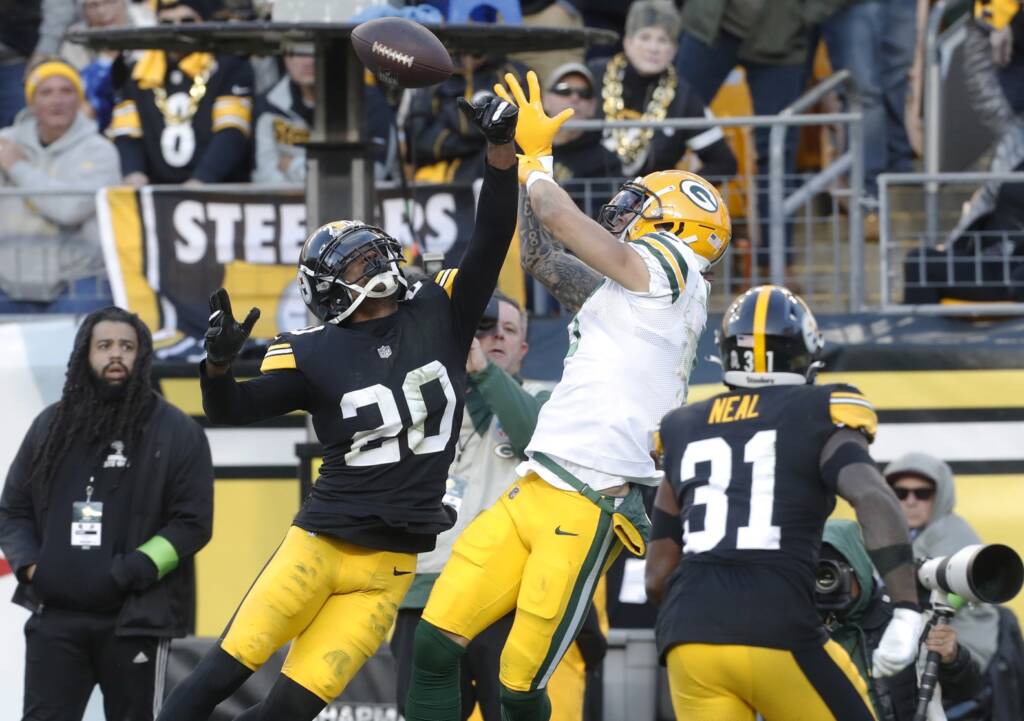This offseason has seen a feverish run of contract extensions for wide receivers across the National Football League. Since the start of the new year, we’ve seen eight wide receivers get contracts worth $23-plus million in average annual value (AAV). The Minnesota Vikings capped off the spending spree by signing Justin Jefferson to a four-year, $140 million extension, with $110 million in guaranteed money, making him the highest-paid non-quarterback in the NFL at $35 million AAV.
In stark contrast, the Green Bay Packers’ top four receivers, Christian Watson, Romeo Doubs, Jayden Reed, and Dontayvion Wicks, will cost a little over $13.5 million over the next two seasons. ESPN Analytics graded Watson, Doubs, Reed, and Wicks above average. Green Bay’s wide receiver room is their current roster-building cheat code. It allows them to pay veterans on defense and will help give them flexibility in the early years of an anticipated Jordan Love extension.
Ultimately, the Packers will likely aim to extend one or two members of their current wide receiver corps. That decision will likely not come until next offseason at the earliest. However, this offseason provides some interesting case studies on approaches to wide receiver contract extensions.
Whether it’s the depth or talent of the group, no individual receiver has had a full breakout season. Of the five largest contracts Green Bay has handed out this offseason to wide receivers, each of DeVonta Smith, A.J. Brown, Jaylen Waddle, Amon-Ra St. Brown, and Justin Jefferson had averaged three 1,000-plus-yard seasons before their extensions. Comparatively, none of the Packers receivers have had a season with 800-plus receiving yards. Houston Texans receiver Nico Collins was the outlier who got paid at a high level and had less production.
Collins is a 2021 third-round draft pick heading into his fourth season and signed a three-year $72.75 million extension with $52 million guaranteed. The deal included a $17 million signing bonus, which gave Collins additional money upfront and allowed the team to spread his bonus throughout the three-year extension and the final year of his rookie deal. In some sense, Collins’ contract looks a bit more like a four-year, $75 million deal for around $18.75 million AAV.
He had inconsistent performance leading up to the extension. Collins had a breakout season in 2023 and was phenom rookie C.J. Stroud’s go-to target, leading the team in 109 targets, 80 receptions, 1,297 yards, and eight touchdowns. If the Texans get that same player for the rest of the Collins extension, it’s a slam-dunk move and amazing value.
However, Collins struggled with injuries and sub-par quarterback play before Stroud’s arrival. He has dealt with injuries every year he’s been in the league, including missing seven games in 2022 with groin and foot injuries. Additionally, Collins had Davis Mills, Tyrod Taylor, Kyle Allen, and Jeff Driskel as his quarterbacks in 2021 and 2022, which leaves much to be desired. As a result, Collins didn’t surpass 40 catches or 500 yards in his first two seasons.
When looking at Collins, an oft-injured player who suddenly puts his game together and starts to reach his potential, I can’t help but think of Christian Watson. When he’s been on the field, Watson has been a big-play threat. He has ranked in the top 20 WRs in yards per reception for receivers in his first two years (minimum 50 targets). Watson has also dealt with his fair share of injuries, including lingering hamstring issues in 2022 and 2023.
But this offseason, Watson visited specialists at UW-Madison’s Badger Athletic Performance to dive deep into the prevention and treatment of his recurring hamstring issues. They discovered a significant asymmetry between his legs, causing overcompensation and additional stress on one side, leading to a higher risk of soft tissue injuries. Watson said he “was around twentysomething percent (off)” and “now I’m probably like 10% to 12% better than that.” While perfect symmetry is impossible, the insight and ability to work smarter to address his biomechanics to stay on the field could allow Watson a chance for a healthier season.
The next big step for Watson will be earning his opportunities in a competitive room with many mouths to feed. Love recently mentioned that wide receiver depth is a good problem, saying, “You don’t have to have a No. 1 receiver. It works out well. We can spread the ball out, and you get different guys making different plays in different areas. I think it puts a lot more stress on the defense.”
Matt LaFleur echoed a similar sentiment about the room: “The hardest part is we feel so good about them all. It’s hard to get them as many touches as you’d like.”
Ultimately, I think performance will dictate a lot. If Watson can maintain his career 15-yards-per-catch average, he could approach Collins’ 80 reception mark. If he does, that equates to around a 1,200-yard season, which could motivate the Packers to proactively extend him.
With the salary cap growing to $255.6 million this past year, money is only going up in the NFL. Depending on your projection source, the cap could reach between $260 million (Over the Cap) and $273 million (Spotrac) next year. If you put an increase in line with cap growth, a Collins-like extension for Watson would be a three-year, $75 to $80 million deal, taking Watson potentially through his age-29 season. That type of extension could line Watson up for one more payday while still producing at his prime. It’s also the type of smart, forward-thinking move to manage Green Bay’s salary cap proactively. It’d be a win-win. All of it comes down to how Watson and the other wide receivers play this season. It’s a subplot I’ll be following closely.

